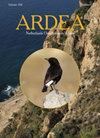Long-Term Trends in Laying date and Fledged Young of Barn Swallow Hirundo rustica in Two Regions of the Netherlands
IF 1.3
4区 生物学
Q3 ORNITHOLOGY
引用次数: 0
Abstract
Since 1992, Dutch volunteers have monitored the breeding attempts of Barn Swallows on a systematic basis. For two regions – Noord-Veluwe and Twente – a dataset of 27 years (1992–2018) was available. This paper examines the timing of breeding and the number of fledglings per successful breeding attempt. As spring and summer weather in Western Europe became on average warmer during this period, we analysed whether Barn Swallows adapted to this shift. The laying date of first broods advanced on average 2.3 days per ten years. The average advancement of laying date of second broods was 2.9 days per decade. The average number of fledglings per successful breeding attempt was constant over time, but showed large inter-year-variation. First broods consistently produced 0.6 fledglings more than second broods. These results are in line with results from similar studies in Western Europe. Contrary to our expectations, neither large scale nor local weather parameters were found to explain the advancement of laying and the number of fledged young. It is essential to study key species like Barn Swallows during all stages of their life cycle over a long time span and large spatial scale to be able to unravel potential effects of climate change. Our study demonstrates that volunteers can contribute essential demographic data. Ideally, these demographic parameters would be monitored with individually marked (colour-ringed) birds. Frequent quality checks and feedback to volunteers are key to maximize the quality of the data collected through long-term volunteer surveys.荷兰两个地区仓燕Hirundo rustica产卵期和幼龄的长期趋势
自1992年以来,荷兰志愿者一直在系统地监测谷仓燕子的繁殖尝试。对于Noord Veluwe和Twente这两个地区,有一个27年(1992-2018)的数据集。本文研究了繁殖的时间和每次成功繁殖的雏鸟数量。在此期间,西欧的春季和夏季天气平均变暖,我们分析了Barn Swallows是否适应了这种变化。第一窝产卵期平均每10年提前2.3天。第二窝产卵期的平均提前量为每10年2.9天。每次成功繁殖的雏鸟平均数量随着时间的推移是恒定的,但表现出较大的年间变化。第一窝始终比第二窝多出0.6只雏鸟。这些结果与西欧类似研究的结果一致。与我们的预期相反,无论是大规模还是当地的天气参数都无法解释产卵的进展和成熟幼崽的数量。至关重要的是,要在长时间和大空间尺度上研究像Barn Swallows这样的关键物种在其生命周期的各个阶段,才能揭示气候变化的潜在影响。我们的研究表明,志愿者可以提供基本的人口统计数据。理想情况下,这些人口统计参数将通过单独标记(彩环)的鸟类进行监测。频繁的质量检查和对志愿者的反馈是最大限度地提高通过长期志愿者调查收集的数据质量的关键。
本文章由计算机程序翻译,如有差异,请以英文原文为准。
求助全文
约1分钟内获得全文
求助全文
来源期刊

Ardea
生物-鸟类学
CiteScore
2.10
自引率
0.00%
发文量
49
审稿时长
>12 weeks
期刊介绍:
Ardea is the scientific journal of the Netherlands Ornithologists'' Union, and is published since 1912. The journal welcomes manuscripts reporting significant new findings in ornithology, in particular those covering the ecology, life history, and evolution of birds, and including sound descriptive work. Ardea publishes Original research papers, Short notes and Book reviews. In addition to the regular three issues per year, Ardea publishes specials that contain conference or workshop proceedings (produced on request).
 求助内容:
求助内容: 应助结果提醒方式:
应助结果提醒方式:


